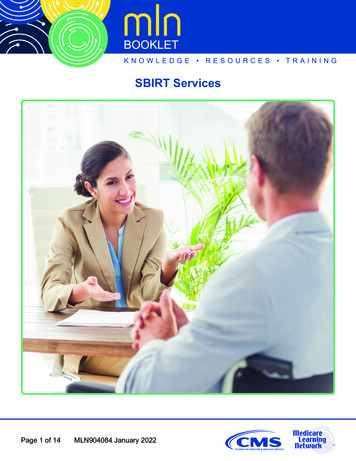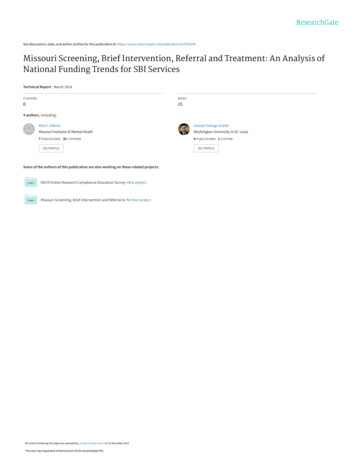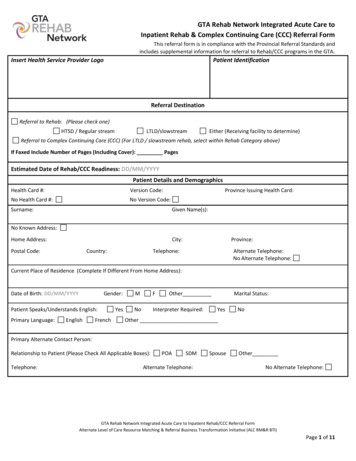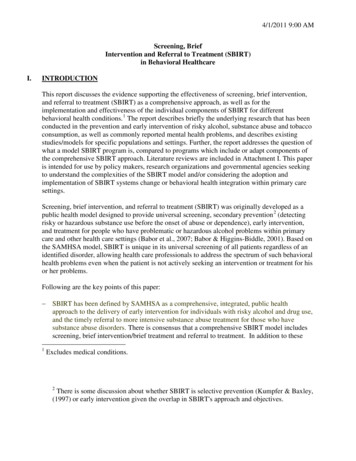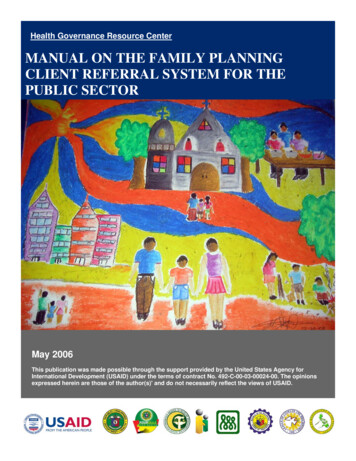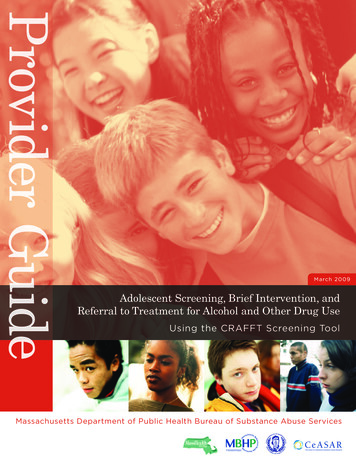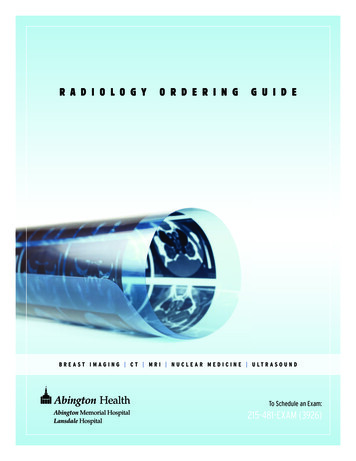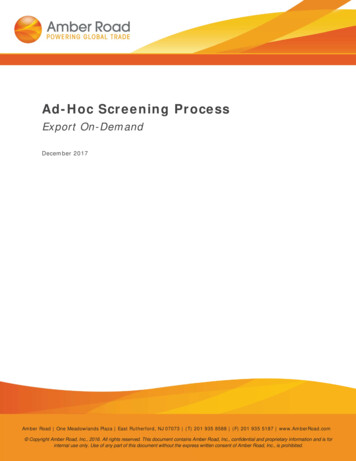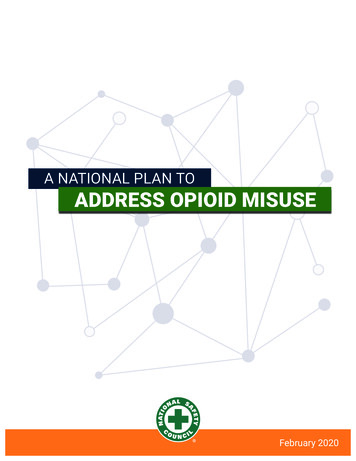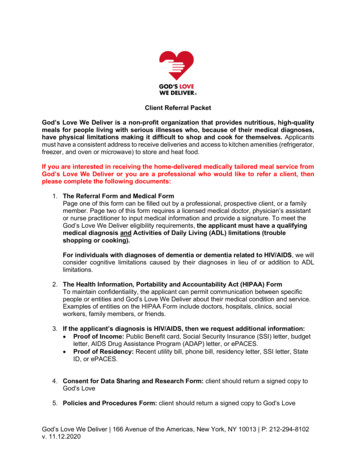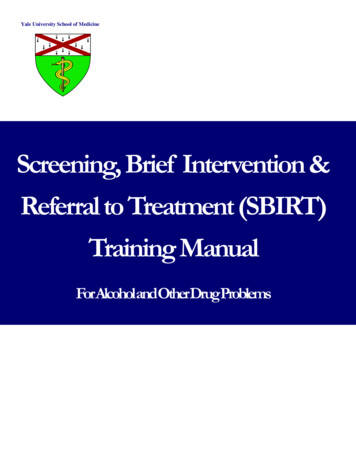
Transcription
Yale University School of MedicineScreening, Brief Intervention &Referral to Treatment (SBIRT)Training ManualForAlcoholandOtherDrugProblems
Screening, Brief Intervention & Referral toTreatment (SBIRT) Training ManualForAlcohol and Other Drug ProblemsGail D’Onofrio MD, MS1Michael V. Pantalon Ph.D. 2Linda C. Degutis DrPH1Patrick G. O’Connor MD3David Fiellin MD3Patrica Owens MS1Shara Martel-Regan MPH1Department of Emergency Medicine, 2Department of Psychiatry, Division of Substance Abuse & 3Department ofMedicine, Section of General Internal MedicineYale University School of MedicineNew Haven, CT1Supported by: SAMHSA/CSAT, Grant #: 1U79TI020253, Principal Investigator: Gail D’Onofrio MD, MS 2008 SBIRT Project- Yale University School of Medicine2
TABLE OF CONTENTSI.Overview of the ManualII. Background Information & Overview of SBIRTIII. ScreeningIV. Brief Intervention & Referral to Treatment: AnOverview of the Brief Negotiation Interview (BNI)V. The 4 Steps of the BNIVI. Additional Motivational StrategiesVII. Common ProblemsVIII. Additional ScreenersIX. AppendicesX. References345-77-121314-2526272832-6162
I. Overview of the ManualThis manual is an adaptation of an earlier manual on Emergency Department (ED) clinicianadministered brief intervention for harmful and hazardous alcohol drinkers. The current manual isdesigned to provide the medical practitioner with the necessary skills to easily and effectively perform1) evidence based screening, 2) a brief intervention, the Brief Negotiation Interview (BNI) and 3) afacilitated referral to treatment for alcohol and other drug problems. Special attention is given todecision-making process regarding whether to use the brief intervention to promote a reduction of useor abstinence versus a referral to a formal substance abuse treatment program. The followingsections provide background information on and describe the critical components of administeringscreening tools for alcohol and other drugs in a variety of medical settings (e.g., ED, OB/Gyn,Pediatrics) and conducting BNIs for both use reduction and referral to treatment. Additionalmotivational and troubleshooting strategies, as well as other helpful resources (e.g., pros and cons ofalcohol & drug use, withdrawal checklists, sample BNI dialogues) are provided. While the manualgives the reader a critical overview of SBIRT, participation in a 2-hour training course, followed bysuccessful completion of a supervised test case is required to be fully prepared to effectively conductSBIRT encounters with patients. Suggestions for periodic review of cases and feedback onperformance, as well as booster training sessions, in order to ensure effective and consistent SBIRTimplementation, are also provided.4
II. Background InformationIntroductionScreening, Brief Intervention & Referral to Treatment (SBIRT) for alcohol and/or other drug problemsare critical skills for the health care practitioner because the use of these substances and the myriadmedical, social and legal problems they cause are highly prevalent, frequently undetected andtreatable in a variety of medical settings. This introduction will cover each of these issues with anemphasis on evidence-based procedures to assist the health care practitioners in identifying andtreating these problems in their day-to-day practices.Prevalence of Alcohol & Drug ProblemsUnhealthy alcohol use 1 is a major preventable public health problem resulting in over 100,000deaths each year 2 and costing society over 185 billion dollars annually. 3 The effects of unhealthyalcohol use have far reaching implications not only for the individual drinker, but also for the family,workplace, community, and the health care system. Based on recent survey conducted in 2007, anestimated 19.9 million Americans aged 12 or older were currently using illicit drugs, includingmarijuana/ hashish, cocaine, heroin, hallucinogens, inhalants, or prescription-type psychotherapeuticsused nonmedically. This estimate represents 8.0 percent of the population aged 12 years or older. Inthat same year, 23.2 million persons needed treatment for an illicit drug or alcohol problem.For example, opioid dependence is a major public health concern and remains primarily anuntreated medical condition in the United States. In 2006 there were approximately 560,000individuals who used heroin in 2006, and 11.4 million individuals who had non-medical use ofprescription opioids. 4 Economic costs of opioid dependence are estimated at greater than 21billion/year and have far reaching implications for the individual, workplace, society and thehealthcare system. 5 Untreated opioid dependence is associated with HIV transmission via injectiondrug use and high risk sexual behaviors. 6 However, treatment is associated with significant individualand society benefits, 7 and opioid agonist treatment, including methadone and buprenorphine, hasbeen demonstrated to be the most effective treatment. However, opioid dependent patients often donot seek help through specialized treatment centers, but do frequently visit Emergency Departments(ED) of hospitals, either for medical consequences of theirs addictive disorder or for comorbidmedical and psychiatric conditions. 8 Many of these patients, particularly young adults, have few ifany other interactions with the health care system. Therefore, the medical visit may be their onlycontact with the treatment system and represents an ideal opportunity for screening, intervention andreferral for treatment.Lack of DetectionOf the 23.2 million people in need of treatment for substance abuse problems in 2007, only 2.4million received treatment and 20.8 million did not receive treatment. Of the 20.8 million people whodid not receive treatment, 1.3 million felt they needed treatment, 380,000 reported they made aneffort to get treatment, and 955,000 reported making no effort to get treatment. 9 Much of the lack oftreatment engagement is due to a lack of detection of problematic use by the health care provider.1,15,395
Brief Interventions Work for Alcohol, Tobacco and Other Drug UseBrief interventions are short counseling session, ranging from 5-60 minutes that incorporatefeedback, advice, and motivational enhancement techniques to assist the patient in reducing theiralcohol consumption to low-risk guidelines thereby reducing their risk of illness/injury. The BriefNegotiation Interview (BNI) used in this grant was first developed in 1994 by Drs Edward Bernstein,Judith Bernstein and Gail D’Onofrio in consultation with Dr. Stephen Rollnick for Project ASSERT inthe ED. 10,11 It was later refined and tested for hazardous and harmful drinkers in the ED by ourresearch team. 12There is compelling evidence in the literature that brief interventions for alcohol problems areeffective 13,14 in a variety of settings including primary care 15,16 and inpatient trauma settings. 17 EDbased randomized controlled trial testing the effectiveness of screening, brief intervention and referralto treatment have had mixed results. Researchers in Germany studied a computer-generatedintervention in injured patients presenting to an ED and found a significant decrease in alcoholconsumption in the intervention group, 18 while two other studies reported a similar decrease inalcohol consumption in the intervention and control groups but demonstrated significant reductions innegative consequences after the initial brief intervention session 19 or a booster session 20 in theintervention group. One study detected no difference in consumption between the intervention andcontrol groups. 21 Our own study (see preliminary data section) that enrolled both injured andnoninjured patients with harmful and hazardous drinking showed similar significant reductions in thecontrol and BNI groups, without a treatment effect. 22 Cohort studies without control groups haveshown a significant reduction in alcohol use. 23 A recently published study conducted at 14 ED sitesthat used a quasiexperimental comparison group design, in which we participated, revealed thatscreening, brief intervention and referral for treatment on patients with all degrees of unhealthyalcohol use was effective. A total of 1,132 patients were enrolled (581 control, and 551 intervention(BNI)). At 3-month follow-up, the BNI group reported consuming 3.25 fewer drinks per week thancontrols. Of the at risk drinkers, 37% no longer exceeded NIAAA low-risk guidelines compared with19% in the control group, 95% CI 12% to 26% (see preliminary study section). A more recent metaanalysis of strategies targeting alcohol problems in the ED examined the extent to which interventionswere effective in reducing alcohol consumption and related harm. 24 Meta-analysis revealed thatinterventions did not significantly reduce subsequent alcohol consumption, but were associated withapproximately half the odds of experiencing an alcohol-related injury (OR 0.59, CI 0.42-0.84).Brief interventions have long been shown to be effective in treating tobacco use and dependencein all populations including adolescents, pregnant women, older adults and racial and ethnicminorities. 25,26,27,28 As a result formal clinical practice guidelines have been developed for treatingtobacco use by a US public Health Panel and Consortium. 29Few studies have investigated brief interventions in drug users. Bernstein and colleagues reportedtheir experience with Project ASSERT in Boston, which used health promotion advocates to screenfor alcohol and other drug use in an urban ED. 30 This cohort study showed that during a one yearperiod of time, 2,931(41%) patients screened positively for substance abuse. Of the 1,096 enrolled ina follow up program, 245 kept a referral appointment and demonstrated a significant 45% reduction inseverity of drug problems and a 56% reduction in alcohol use. More recently Bernstein andcolleagues tested the impact of a single, structured encounter by similar peer educators that targetedcessation of dug use in a hospital’s hospital “Walk-In” Clinics. 31 Of the 1175 patients enrolled, theintervention group at 6 months was more likely to be abstinent than the control group for cocaine(22.3% versus 16.9%), heroin (40.2% versus 30.6%), and both drugs (17.4% versus 12.8%). Anotherstudy evaluated the effect of a brief alcohol intervention for injection drug users at a needle exchangefacility. 32 Significant reductions were observed in both treatment conditions; participants reported an6
average of 12.0 drinking days at baseline and 8.3 at 6 months. Those in the brief intervention groupwere over two times more likely than controls to report reductions of 7 days or more, P 0.05.These findings support further investigation of brief intervention for drug use in the ED. Given thechronic and relapsing nature of drug and alcohol dependence, the goal of these brief interventionsmay be to facilitate an effective referral for the patient to a formal treatment program which can havean impact on reducing drug use.The Medical Visit is an Opportunity for InterventionGiven the significantly higher rate at which people see their medical doctors (versus a substanceabuse specialist), the medical visit offers a potential “teachable moment” where health carepractitioners have a unique opportunity to motivate change in alcohol and/or drug use behaviors. 33 Inessence, the medical practitioner has a captive audience. Given the high prevalence and frequentlack of detection of alcohol and drug problems, as well as their negative consequences and positiveresponse to evidence-based treatment, the health care practitioner armed with competent SBIRTskills can make the difference in forestalling the progression of risky use to dependence, or effectivelymotivating a patient who is already on the severe end of the spectrum to engage in a treatmentprogram.In the following 2 sections, we will review the steps needed to effectively administer the 2 main partsof SBIRT, that is 1) Screening and 2) Brief Intervention & Referral to TreatmentIII. ScreeningThe components of evidence-based screening, where we are attempting to detect the type andlevel of substance use in our patients, include decisions around 1) what type of substance thescreening is for, 2) what type of substance problem is of interest (i.e., harmful or hazardous use,dependence, lack of treatment), 3) what questions to ask and 4) how to score the screening measure.For the first component of screening, decide what substance is of interest, alcohol or illicitdrugs (e.g., cocaine, heroin, marijuana) or both. Then, based on Table 1, select the substanceproblem of interest. For alcohol, the choices are harmful or hazardous (“at-risk”) drinking,dependence. For illicit substances, the choices are the same except for “at-risk” use, as there are noacceptable guidelines for non-risky use of drugs. Depending on the first two decisions, the healthcare provider will select the appropriate screening measure(s), and administer and score them asdescribed below and in the “Additional Screeners” section.TABLE 1: Substance, Problem, ScreenerSubstance ProblemAlcoholOn a continuumfrom at risk todependenceIllicitDrugsOn a continuumfrom use todependenceScreenerNIAAA quantity frequency: Identifies those who are over low riskamountsAUDIT, TWEAK: (for pregnant women), CRAFFT (foradolescents): May offer additional information regarding negativeconsequencesCAGE: 2 is a brief assessment for dependenceNIAAA Screener adapted for drugsCAGE-Adapted to Include Drugs (CAGE-AID), DAST, modifiedCRAFFT (for adolescents)7
The most frequently used of the above screeners will be described in detail (administration andscoring procedures) below, while information on the other measures will be offered in section VIII“Additional Screeners” of this manual.Screening proceduresA) ALCOHOL1) Harmful/Hazardous (“at-risk) drinkingThe most commonly used screener for harmful/hazardous drinking is what is commonly referred to asthe NIAAA (National Institute for Alcohol Abuse & Alcoholism) Quantity/Frequency screening Inorder to competently administer the NIAAA screener, one first needs to know the followinginformation (see figure below) regarding what equals a “standard drink.”Figure 1:WHAT IS A STANDARD DRINK?1 Standard Drink equals:ordrink made with 1.5 oz.12 oz. Beerof alcohol (whiskey, gin, etc.)5 oz. wineTABLE 2: NIAAA SCREENING for Harmful & Hazardous (“Atrisk”) Alcohol Use1. How many days per week do you drink alcohol?2. On a typical day when you drink, how many standarddrinks do you have?3. What is the maximum number of standard drinks you hadon any given day in the past month?8
TABLE 3: SCORING THE NIAAA SCREENER# STANDARD DRINKS FORAT-RISK (Hazardous*)DRINKINGPerPerWeek** OccasionMen 14 4Women 7 3All 65 7 3*At-risk/Hazardous Drinking ALSO includes those who drink under potentially dangerous situations(e.g., while operating heavy machinery, while driving)Harmful Drinking pertains to those who (whether or not they score above the drinking limits in Table3) have are currently experiencing at least one problem (medical/social) related to alcohol. They do,however, also often meet the above NIAAA guidelines for at-risk drinking.** Sometimes even 1 drink is too much! If you are: driving or planning to drive at work or returning to work pregnant, or breast feeding on medication have certain medical conditions2) Alcohol DependenceThe most common screener for more severe alcohol problems (a consistent pattern of problemsrelated to alcohol in 1 area of a patient’s life) and dependence (a consistent pattern of problemsrelated to alcohol in 3 areas of a patient’s life) is referred to as the “CAGE” screener.TABLE 4: The ALCOHOL “CAGE” ScreenerC: Have you ever thought you should cut down on yourdrinking?A: Have people annoyed you by criticizing your drinking?G: Have you ever felt bad or guilty about your drinking?E: Have you ever had a drink first thing in the morning tosteady your nerves or get rid of a hangover? (eye opener)9
TABLE 5: SCORING THE ALCOHOL “CAGE” Screener# CAGE Qsscored positive123 or 4Percent Likelihood ofDependenceAssess further*6486*Assess further with the MINI-SCID (see Appendices of this manual)B) ILLICIT DRUGS1) Screening for UseWhile there are no levels of drug use that would be considered low-risk vs at-risk, the health careprovider may use the aforementioned NIAAA quantity/frequency questions to assess the level ofcurrent drug use in patients. The provider, however, needs to substitute “alcohol” for whatever illicitdrug is being used by the patient and number of “standard drinks” with the relevant route and form ofuse (e.g., “bags” of IV heroin use, e.g., “blunts” of marijuana smoked).2) Screening for Drug DependenceAs illustrated below, the CAGE screener has been adapted to include drug use. This screener is tobe used to assess drug dependence in patients.TABLE 6: ILLICIT DRUGS “CAGE” SCREENER (CAGE-Adapted toInclude Drugs)(CAGE-AID)C: Have you ever thought you should Cut down on your drug use?A: Have people Annoyed you by criticizing your drug use?G: Have you ever felt bad or Guilty about your drug use?E: Have you ever used drugs first thing in the morning to steady your nervesor avoid withdrawal (Eye opener)10
TABLE 7: SCORING THE ILLICIT DRUGS “CAGE” SCREENER(CAGE-Adapted to Include Drugs)# CAGE Qsscored positive123 or 4Percent Likelihood of DrugDependenceAssess further*6486*Assess further with the MINI-SCID (see Appendix 9)Research Findings on Screening in Medical SettingsInternal MedicineThere are many instruments available for screening and brief assessment of alcohol problems.Their effectiveness varies according to their availability, ease of administration and testcharacteristics. 34 Our team has extensive experience evaluating the performance characteristics forscreening for alcohol use in primary care. 35 The NIAAA has traditionally recommended that thepractitioner ask 3 quantity and frequency questions 36 followed by the CAGE questionnaire. 37 Morerecently, NIAAA has advocated for a one question screen that determines whether a patient drinksheavily (5 or more drinks in a day for men or 4 or more for women. 38 The AUDIT, 39 a ten itemquestionnaire, was developed as a screening instrument for hazardous and harmful alcoholconsumption as part of a 12-country World Health Organization study of brief alcohol interventions.Alcohol consumption, drinking behavior, and alcohol-related problems are assessed over thepreceding year. A cutoff score of 8 out of a possible 41 is used as a positive indicator ofhazardous/harmful drinking. The CAGE questionnaire is easy to administer, and performs relativelywell when preceded by the quantity and frequency questions. Saitz reported the validity of using theCAGE as a screening tool for detecting alcohol use disorders in Latinos in the primary care setting. 40While heavy drinking is as common in Latinos as in African Americans and non-Latino whites, seriousconsequences of heavy drinking are more common in Latinos than in other ethnic groups. 41 Despiteits advantages the CAGE questionnaire may be biased in relation to certain groups; one researcherreported that when applied to women, Mexican-American patients and those with annual incomesabove 40,000, they were consistently less likely to endorse each CAGE question “yes” afteradjusting for the alcohol use disorder and pattern of alcohol consumption. 42 The Yale-SBIRT facultyhas published systematic reviews on the performance characteristics of screening methods in primarycare and ED setting. Our results have demonstrated, for instance, that the Alcohol Use DisordersIdentification Test (AUDIT) has the best operating characteristics for detecting harmful and hazardousalcohol use in primary care, whereas the CAGE is better for detecting alcohol dependence. 43 Theseresults also demonstrate the advantage of using formal screening instruments over clinical judgmentor laboratory tests. The curricula on screening will emphasize the science (e.g. sensitivity,specificity) behind the use of various screening toolsObstetrics and GynecologyThe American College of Obstetricians and Gynecologists recommend screening all womenfor at-risk drinking and illicit drug use. 44 Among pregnant women aged 15 to 44, 11.8% admit todrinking some alcohol during the previous month 45, which puts the fetus at risk for fetal alcoholsyndrome, estimated at 1 in 100 children and the leading cause of mental retardation in the U.S.11
Maternal alcoholism is also one of the leading preventable causes of fetal neurodevelopmentaldisorders. 46 Children from low income ethnic minority populations are vulnerable to the long-termeffects of prenatal alcohol exposure, because their mothers are less likely to receive alcoholcounseling during pregnancy. 47 Illicit drug use is associated with increased rates of sexuallytransmitted infections in women, including hepatitis and human immunodeficiency virus as well asdepression, interpersonal violence, poverty and significant prenatal and neonatal complications. 48,49Screens such as the TWEAK 50, T-ACE 51,52,53 or the NIAAA quantity and frequency questions areaccurate in detecting women’s patterns of use, which may differ than men. 54 The TWEAK was firstdesigned to detect “at-risk” pregnant drinkers. It has been shown to have a high sensitivity &specificity in both primary care and general populations, ranging from 83%-100% and 68%-96%respectively, using a cutoff point of 3, when a weight of 2 is applied to tolerance and worry and aweight of 1 is applied to the other three. 55 Chang reviewed alcohol screening tests in pregnantwomen concluding that simple screening questionnaires, such as the T-ACE, were effective indetecting drinking problems.55PediatricsKnight and colleagues developed the 6-item CRAFFT questionnaire as a brief alcohol andother drug screening test 56 and later validated its use in a general population of adolescent medicalpatients in comparison with a structured psychiatric diagnostic interview. 57 More recently Knighttested the validity of CRAFFT with the AUDIT, POSIT, and CAGE questionnaire in detecting alcoholdisorders in 14-18 year olds in a routine adolescent clinic. The AUDIT, POSIT and CRAFFT werefound to have acceptable sensitivity for identifying alcohol problems or disorders in this age group,but the CAGE was not recommended. 58 He also found that the CRAFFT was a reliable means ofscreening adolescents for other drug use. 59Emergency Medicine/SurgeryThe American College of Emergency Physicians, and the Emergency Nurses Association hasadopted the preferred NIAAA quantity and frequency questions followed by the CAGE questionnairein their toolkits for SBIRT. 60 This is primarily due to ease of administration and acceptability bypractitioners. Cherpitel 61 studied the operating characteristics of a variety of screens in the EDsetting. Although CAGE had less sensitivity compared with TWEAK 75% to 87%, the CAGE is oneless question and easy to remember. More recently Cherpitel studied RAPS4 (Rapid AlcoholProblems Screen) in the ED setting compared with ICD-10 and DSM-IV criteria for alcoholdependence and for harmful drinking. A positive response to any one of the four items gave asensitivity of 93% and specificity of 87% for alcohol dependence, and sensitivities were high acrossgender and ethnic subgroups. Sensitivity and specificity for harmful drinking were lower (55% and79%). 62Screening for illicit drug useThere are fewer rigorous evaluations or validated instruments of screening for these disorders,and screening occurs less frequently. Therefore, one of the goals will be to promote the use ofvalidated screening instruments for drug use (e.g. CAGE-D, DAST and ASSIST) in the resident’spractices. The 10-item Drug Abuse Screening Test (DAST-10)63 though not lengthy requires moretime to administer than quantity/frequency scales, and the individual items. Several studies havefound that the 10-item DASTs is effective at screening for drug misuse with good internal reliability,validity, and temporal consistency. 64,65,66 The Alcohol, Smoking and Substance InvolvementScreening Test (ASSIST) was recently developed for the World Health Organization (WHO) in aneffort to screen for problem or risky use of tobacco, alcohol, cannabis, cocaine, amphetamine-typestimulants, sedatives, Hallucinogens, inhalants, opioids and ‘other drugs’ that do not fall into thesecategories. The instrument was developed to use across a broad range of countries and cultures inprimary care settings. 6712
IV. Brief Intervention in SBIRT: An Overview of the Brief NegotiationInterview (BNI)The Brief Negotiation Interview (BNI) described in this grant was first developedin 1994 by Drs Edward Bernstein, Judith Bernstein and Gail D’Onofrio in consultation with Dr.Stephen Rollnick for Project ASSERT in the ED. 68,69 It was later refined and tested for hazardous andharmful drinkers in the ED by the current investigator group. 70The BNI is a short counseling session that is done following screening and that incorporates brieffeedback and advice with motivational enhancement techniques to assist the patient in changingalcohol and/or drug-related behaviors. The BNI procedure is patient-centered and the skills used arebased in large part on the patient’s motivation and readiness to change. The primary outcome of theBNI procedure is the patient’s agreement to reduce alcohol/drug amounts or accept a referral to aformal specialized treatment center to decrease harm (medical problems or trauma). Theinterventionist and patient come to this agreement through a process of negotiation described in thefollowing section.The following are the 4 steps of the BNI:1)Raise The Subject Establish rapport Raise the subject of alcohol or drug use Assess comfort2)Provide Feedback Review patient’s alcohol/drug use and patterns Make connection between alcohol/drug use and negative consequencesIn a variety of areas of life including: medical, legal, family and employment Make connection between alcohol/drug use and the medical visit Discuss issues related to physical dependence, such as tolerance and withdrawal3)Enhance Motivation Assess readiness to change Boost motivation4)Negotiate And Advise Negotiate goal Give advice Summarize and complete referral/or alcohol/drug agreementEach step has critical components, specific objectives, actions and necessary preparations to besuccessful. Details of each step are provided in the following 2 sections, the first for patients whohave screened positive for harmful or hazardous (“at-risk”) drinking and the second for those whohave screened positive for alcohol or drug dependence.13
V. The 4 Steps of the BNIThe following is a detailed description of the actions to be taken during each of the 4 steps of the BNI.In each step, specific directions are given based on whether the patient screened positive for 1)Harmful or Hazardous (“At-risk”) Drinking, in which case the BNI goal would be the patient’sagreement to reduce alcohol use to below NIAAA “at-risk” levels and/or to avoid drinking in potentiallyharmful situations, or 2) Alcohol and/or Drug Dependence, in which case the goal would be thepatient’s agreement to follow-up with a referral to treatment or a reduction of use as the patientconsiders treatment options.STEP1:Raise the SubjectCritical components:1. Be respectful2. Remember the patient is giving you permission to discuss his/her alcohol/druguse is an important aspect of the intervention3. Avoid arguing or being confrontational4. Be mindful of the patients possible physical discomfortPREPARATION (NOT part of screening): Review medical record, Withdrawal Scale, if administered (See Appendix 9), any otheradditional assessments (See Section VIII. Additional Screeners)OBJECTIVESEstablish rapportACTION(S) Introduction and explanationof your roleAvoid a judgmental stanceAcknowledge the patientssituationSet a comfortable climateAsk permission Engage the patient Raise the subjectQUESTIONS/COMMENTS“Hello, I am and I workhere in the .“Would you mind if we spend afew minutes talking about youruse of (fill in withalcohol or drug(s) ofabuse)?” PAUSE “I want to talk about how it’saffecting you and how we mightbe able to help.”14
Assessdiscomfort Ask about any symptoms ofalcohol and/or drug withdrawalsee (if applicable)(see miniSCID & Withdrawal scales inAppendix 9) “Tell me about how you arefeeling right now? When is thelast time you drank/used anydrugs?Reflective listeningREFLECT on any statedconnection between pattern ofalcohol and/or drug use &discomfort/withdrawalsymptomsSUMMARY OF STEP1This first step sets the climate for a successful BNI. Asking permission to discuss the subject ofalcohol/drug use formally lets the patient know that their wishes and perceptions are central to thetreatment which later enhances that the patient will accept a referral to treatment if necessary.Further reflecting on patient acknowledged problems and discomfort related to their drug use(whether stated by the patient or assessed with other measures, such as the mini-SCID and/orwithdrawal scales found in the “Appendices” section, motivates the patient to start consideringcompelling reasons for change, but without being confronted with this information in a harsh (i.e.,non-motivational) manner.15
STEP2:Provide FeedbackCritical components:1. Review current alcohol/drug use and patterns and dependence symptoms2. Compare the patients drinking to national norms Discuss the role of alcohol/drug use ondifficult areas of life (financial, family, employment, health, legal)3. Make the connection between alcohol/drug use and reason for medical visit and risk ofHIV/AIDS (if applicable)4. Discuss issues related to physical dependence such as withdrawal and need tocontinually use alcohol/drugs (if applicable)5. Inform patient that a variety of treatments work effectively reduce and stop
Introduction Screening, Brief Intervention & Referral to Treatment (SBIRT) for alcohol and/or other drug problems are critical skills for the health care practitioner because the use of these substances and the myriad
